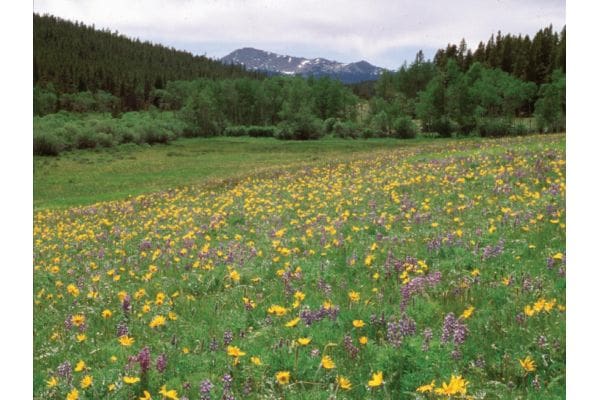NWTF Strengthens Commitment to Mitigate Wildfire Threats in Rocky Mountain Region

EDGEFIELD, S.C.—Thanks to the cooperative National Master Stewardship Agreement, the NWTF and the USDA Forest Service have expanded their efforts in the Rocky Mountain Region, which encompasses Wyoming, Colorado, South Dakota, Nebraska and Kansas. These efforts will reduce the threat of catastrophic wildfire and improve wildlife habitat on targeted, high-priority landscapes within the agency’s Region Two.
“Given the forest health crisis in Wyoming and Colorado, I am excited for the National Wild Turkey Federation to take on this important work as a Keystone Partner under the Wildfire Crisis Strategy,” said Molly Pitts, NWTF Wildfire Crisis Strategy manager.
On September 22, the Region Two Supplemental Project Agreement was officially signed, and includes four projects:
Big Horn National Forest
The entirety of Sheridan’s municipal water supply relies exclusively on the Big Goose watershed within the Bighorn National Forest. One of the primary challenges facing this watershed is the threat of sedimentation and debris, as large fires pose a significant risk to the overall quality of the water.
To mitigate these potential risks, two projects will be completed. The Blondie project includes the removal of 362 acres of lodgepole pine trees, and the Cheap Trick project will treat an additional 174 acres. The overarching goal of these projects is to diminish the likelihood of adverse impacts on water quality stemming from catastrophic wildfires.
Furthermore, these treatments will contribute to bolstering the overall resilience of the forest, reducing the intensity of fires and mitigating the impacts of insects and disease. Additionally, the project includes the restoration of aspen and riparian communities, which will serve as natural fuel breaks, offer enhanced wildlife habitat and contribute to an increase in species diversity within the area.
White River National Forest
The Cottonwood Stewardship project encompasses 325 acres of land, consisting of two main components: a clear-cut area covering 57.8 acres of lodgepole pine and a partial-cut area spanning 267.6 acres. The majority of the saw timber volume in this project will come from salvage (dead) lodgepole pine, with minor quantities of salvage Engelmann spruce and true fir.
The primary objective of this initiative is to bolster the forest’s resilience in the face of various disturbances, including potential future bark beetle outbreaks and catastrophic wildfires. Achieving this goal involves carefully managing the stand density within young lodgepole pine stands. By doing so, it will reduce the risk of fire spreading, promote faster tree growth rates and effectively remove invasive species. Additionally, these treatments will lead to increased forage productivity for native wildlife, ensuring a better chance of survival during critical periods throughout the year.Top of Form
San Juan National Forest
The First Notch project encompasses 2,993 acres within the National Forest, focusing on both commercial and non-commercial thinning. This undertaking aims to yield several positive outcomes, notably enhancing the diversity of plant and wildlife populations while bolstering their resilience against the threats of catastrophic wildfires, insects, and diseases.
Additionally, the implemented treatments will significantly curtail the financial burden associated with wildfire suppression efforts. They will also contribute to the sustainable provision of timber products, catering to the needs of both the industry and the local community.
“These four projects are just the start of what we hope will be many more projects in Region Two,” Pitts said.
This work is a component of the Wildfire Crisis Strategy, which the Forest Service formally announced in January 2022. Almost two years into the 10-year effort, the Wildfire Crisis Strategy is implementing a scaled-up, cross-boundary approach to reduce 20 million acres of hazardous fuels on Forest Service lands and up to 30 million acres beyond Forest Service lands with an array of agency, tribal and conservation partners. The NWTF has worked with the Forest Service in both developmental and implementational capacities on the strategy.
Accelerated on-the-ground efforts between the NWTF and the Forest Service began earlier this year in the Forest Service’s Region Five on the Klamath National Forest with a nearly 3,000-acre fuels reduction project. Forest products from this project made their way to a wood mill in Wyoming by railcar via the collaborative Timber Transfer Pilot, a proof-of-concept approach to show the social and ecological benefits of reinvigorating the age-old method of transporting timber, which could establish a new paradigm for future fuels reduction work.
The NWTF’s involvement in the Wildfire Crisis Strategy is critical to conserving wild turkeys and preserving North America’s hunting heritage.
About the National Wild Turkey Federation
Since 1973, the National Wild Turkey Federation has invested over half a billion dollars into wildlife conservation and has conserved or enhanced over 22 million acres of critical wildlife habitat. The organization continues to drive wildlife conservation, forest resiliency and robust recreational opportunities throughout the U.S. by working across boundaries on a landscape scale.
2023 is the NWTF’s 50th anniversary and an opportunity to propel the organization’s mission into the future while honoring its rich history. For its 50-year celebration, the NWTF has set six ambitious goals: positively impact 1 million acres of wildlife habitat; raise $500,000 for wild turkey research; increase membership to 250,000 members; dedicate $1 million to education and outreach programs; raise $5 million to invest in technology and the NWTF’s people; and raise $5 million to build toward a $50 million endowment for the future. Learn how you can help us reach these lofty goals.
